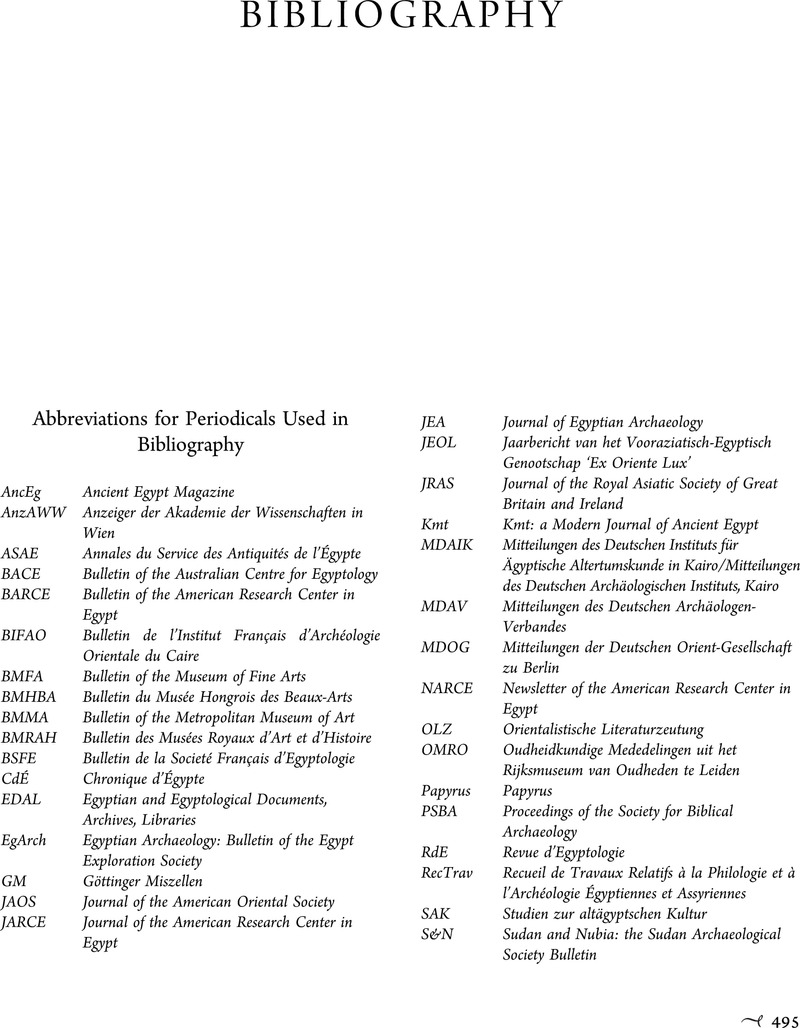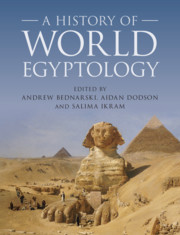Book contents
- A History of World Egyptology
- A History of World Egyptology
- Copyright page
- Dedication
- Contents
- Figures
- Notes on Contributors
- Preface
- A Note on Academic Titles
- Abbreviations and Conventions Used in Text
- Maps
- Introduction
- Chapter 1 The Prehistory of Egyptology
- Chapter 2 Egypt
- Chapter 3 France
- Chapter 4 The British Isles
- Chapter 5 The Netherlands
- Chapter 6 Belgium
- Chapter 7 The Nordic Countries
- Chapter 8 Prussia and Germany
- Chapter 9 The Empire of Austria-Hungary and the Republic of Austria
- Chapter 10 Switzerland
- Chapter 11 Hungary
- Chapter 12 Czechoslovakia
- Chapter 13 Poland
- Chapter 14 Russia
- Chapter 15 Italy
- Chapter 16 Spain
- Chapter 17 United States of America
- Chapter 18 Canada
- Chapter 19 Japan
- Chapter 20 Australasia
- Chapter 21 Ancient Egypt in the Cinema
- Chapter 22 Past and Future
- Bibliography
- Index
- References
Bibliography
Published online by Cambridge University Press: 01 June 2021
- A History of World Egyptology
- A History of World Egyptology
- Copyright page
- Dedication
- Contents
- Figures
- Notes on Contributors
- Preface
- A Note on Academic Titles
- Abbreviations and Conventions Used in Text
- Maps
- Introduction
- Chapter 1 The Prehistory of Egyptology
- Chapter 2 Egypt
- Chapter 3 France
- Chapter 4 The British Isles
- Chapter 5 The Netherlands
- Chapter 6 Belgium
- Chapter 7 The Nordic Countries
- Chapter 8 Prussia and Germany
- Chapter 9 The Empire of Austria-Hungary and the Republic of Austria
- Chapter 10 Switzerland
- Chapter 11 Hungary
- Chapter 12 Czechoslovakia
- Chapter 13 Poland
- Chapter 14 Russia
- Chapter 15 Italy
- Chapter 16 Spain
- Chapter 17 United States of America
- Chapter 18 Canada
- Chapter 19 Japan
- Chapter 20 Australasia
- Chapter 21 Ancient Egypt in the Cinema
- Chapter 22 Past and Future
- Bibliography
- Index
- References
Summary

- Type
- Chapter
- Information
- A History of World Egyptology , pp. 495 - 552Publisher: Cambridge University PressPrint publication year: 2021
References
Bibliography
Ancient Egypt Magazine
Anzeiger der Akademie der Wissenschaften in Wien
Annales du Service des Antiquités de l’Égypte
Bulletin of the Australian Centre for Egyptology
Bulletin of the American Research Center in Egypt
Bulletin de l’Institut Français d’Archéologie Orientale du Caire
Bulletin of the Museum of Fine Arts
Bulletin du Musée Hongrois des Beaux-Arts
Bulletin of the Metropolitan Museum of Art
Bulletin des Musées Royaux d’Art et d’Histoire
Bulletin de la Societé Français d’Egyptologie
Chronique d’Égypte
Egyptian and Egyptological Documents, Archives, Libraries
Egyptian Archaeology: Bulletin of the Egypt Exploration Society
Göttinger Miszellen
Journal of the American Oriental Society
Journal of the American Research Center in Egypt
Journal of Egyptian Archaeology
Jaarbericht van het Vooraziatisch-Egyptisch Genootschap ‘Ex Oriente Lux’
Journal of the Royal Asiatic Society of Great Britain and Ireland
Kmt: a Modern Journal of Ancient Egypt
Mitteilungen des Deutschen Instituts für Ägyptische Altertumskunde in Kairo/Mitteilungen des Deutschen Archäologischen Instituts, Kairo
Mitteilungen des Deutschen Archäologen-Verbandes
Mitteilungen der Deutschen Orient-Gesellschaft zu Berlin
Newsletter of the American Research Center in Egypt
Orientalistische Literaturzeutung
Oudheidkundige Mededelingen uit het Rijksmuseum van Oudheden te Leiden
Papyrus
Proceedings of the Society for Biblical Archaeology
Revue d’Egyptologie
Recueil de Travaux Relatifs à la Philologie et à l’Archéologie Égyptiennes et Assyriennes
Studien zur altägyptschen Kultur
Sudan and Nubia: the Sudan Archaeological Society Bulletin
Varia Aegyptica (San Antonio, TX: Van Siclen Books)
Zeitschrift für Ägyptische Sprache und Altertumskunde
Zeitschrift der Deutschen Morgenländischen Gesellschaft
Zeitschrift für Papyrologie und Epigraphik



